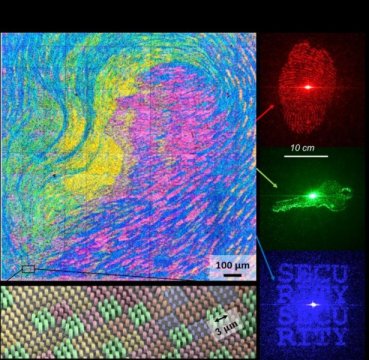[ad_1]
Researchers from the Singapore University of Technology and Design (SUTD) have invented a new type of anti-counterfeiting device that can be useful for counterfeit deterrence of important documents such as identity cards, passports and banknotes. Calling it “holographic colour prints,” the research team led by Associate Professor Joel Yang demonstrated an optical device that appears as a regular colour print under white light, but projects up to three different images onto a distant screen when lit up with laser pointers. Unlike regular diffractive optical elements that have a frosted-glass appearance and projects only single images, these new holographic colour prints can be a stronger deterrent to counterfeiters while looking pretty at the same time. In addition, the prints consist of nano-3D-printed polymer structures and find particular use in optical document security.
Counterfeiting is a great menace to daily life, and the global anti-counterfeiting industry will reach more than US$ 357 billion by 2026 according to a report from Credence Research. Anti-counterfeiting products are important and essential for protecting products and documents. The most popular anti-counterfeiting products are based on holograms that can be found everywhere including on electronic device package boxes, medicine bottles, and surfaces of bank cards. However, these anti-counterfeiting hologram products only modulate the phase of light and can be easily copied.
The SUTD research team developed a new type of anti-counterfeiting device, i.e. holographic colour printing, which modulates both the phase and amplitude of light. Holographic colour printing displays a coloured image under ambient white light by tuning the amplitude of light, while projecting up to three different holograms under red, green, or blue laser illumination. This feat was achieved by fabricating a new type of nanostructured pixel strategically arranged on a plane. Each pixel acts as a speed bump (phase control) and road blocks (amplitude control) for light. The dual-function of holographic colour printing increases security and deters counterfeiting.
Associate Professor Joel Yang shared that the device’s colour pixels are created by overlaying structural coloured filters onto phase plates. Nanostructured posts of different heights are employed as structural coloured filters to modulate the amplitude of light. The team developed a computer algorithm that takes multiple images as its input, and generates an output file that determines the positions of different phase and coloured filter elements. The holoscopic print was then sculpted with the aid of a nanoscale 3D printer. The team used Luigi Russolo’s art painting Perfume (1910) as a colour print that is viewable under ambient white light. Different thicknesses of polymerised cuboid are used to modulate the phase plates and form three multiplexed holograms, projected as a red thumbprint, a green key, and blue lettering that reads “SECURITY.” All of these images were embedded within a single print.
“The relationship of holograms in combating counterfeiting is analogous to antibiotics against infections. Every so often, new technology is needed to deter counterfeiters as the old fashioned holograms become easier to copy,” said Joel Yang
He further added, “For the first time, multiple holograms that are color selective are ‘woven’ into a colourful image using advanced nanofabrication techniques. We are hopeful that these new holographic colour prints are user friendly but counterfeiter unfriendly: They are readily verified but challenging to copy, and can provide enhanced security in anti-counterfeiting applications.”
Story Source:
Materials provided by Singapore University of Technology and Design. Note: Content may be edited for style and length.
[ad_2]















